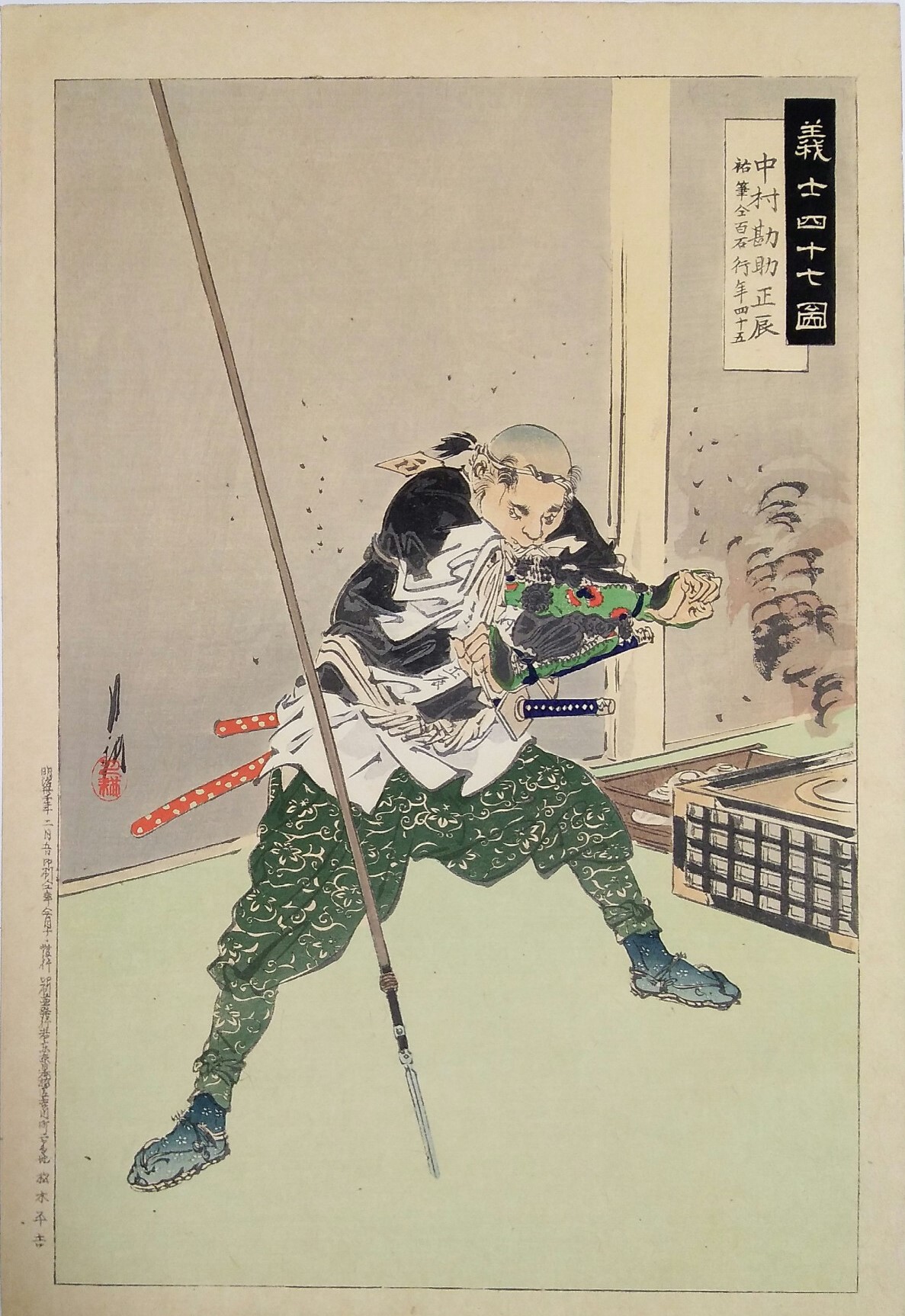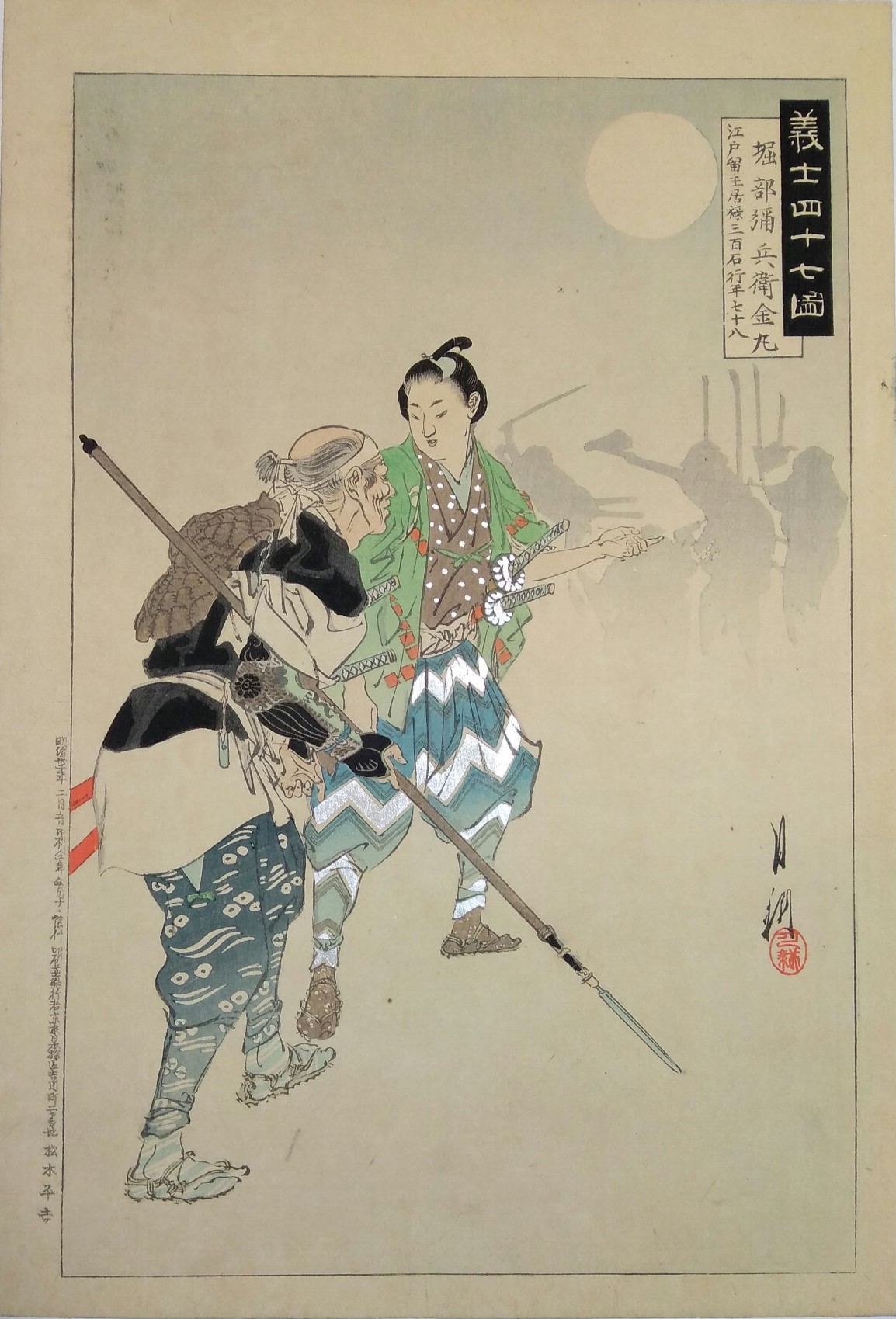Ogata Gekkō
1859 ~ 1920Ogata Gekkō, born in Edo as Nakagami Shōnosuke, in a merchant family, found himself earning a living by designing and selling rickshaw illustrations at the age of sixteen, following his father`s death.
Gekkō grew up as a self-taught artist and promoted himself by selling his services as an illustrator for books and newspapers and as a designer of frontispieces. However, he was also influenced by the work of the great classical
painter Ogata Kōrin, whose artistic legacy, the Ogata school, recognized Gekkō`s talent, allowing him to use their name.
Gekkō broke with the conventions of traditional ukiyo-e prints, introducing a unique style that required printers to adapt techniques typical of watercolor and oil painting to woodblock printing. This often caused technical difficulties,
as his designs did not follow the clear separation of lines and colors typical of ukiyo-e.
Despite not achieving the fame or earnings of artists like Yoshitoshi, he was one of the first Japanese artists to be recognized internationally. Specializing in kacho-e (images of flowers and birds), He mastered the depiction of the details
of bird feathers, and also worked as a decorator of lacquerware and pottery.
After the outbreak of the Sino-Japanese War, Gekkō began creating war prints. As a war correspondent for a newspaper company, he followed the troops to the battlefields, made sketches of the battle scenes, and turned them into prints back in Japan.
He favored a variety of subjects in addition to reporting on the war: flowers and birds, landscapes, beauties, animals, and family scenes. His print series "Beauties at Famous Places" was published in the early 20th century. He received a gold medal
at the 1904 St. Louis World`s Fair for selections from his landscape series "One Hundred Views of Mt. Fuji".
Gekkō perfected his Japanese woodblock print style over the course of his career, blending ukiyo-e printing, Nihonga (Japanese-style painting), Shijō-style painting, and Chinese painting. His rich artistic background and unique approach to printmaking
give his works an appearance more akin to a painting than a traditional print. Other artist names used by Gekkō include Kagyosai, Meikyosai, Nen`yu, and Rosai.
 Not for Sale
Not for Sale
A warrior, presumably Taira no Tadanori, the brother of Taira clan leader Kiyomori, is depicted resting beneath a tree, composing a poem on a strip of paper.
The poem appears within the white cartouche in the upper-right corner of the print. It is drawn from Heike Monogatari (平家物語), one of the most celebrated war epics in Japanese
classical literature, and is traditionally attributed to Tadanori himself:
「行き暮れて 木の下陰を 宿とせば 花や今宵の 主ならまし」
Yuki kurete / ko no shita kage wo / yado to seba / hana ya koyoi no / jinaramashi
"As evening falls and I take shelter beneath the shadow of a tree,
might the blossoms above become my hosts for the night?"
The print employs refined techniques such as karasuri (空摺, blind embossing) on the white cartouche and kirabiki (雲母引, mica printing) on the warrior’s garment, adding both texture and elegance to the composition.
 Not for Sale
Not for Sale
A portrait of Kusunoki Masashige, a samurai lived during the Kamakura era, in the moment of his farewell to his son Masatsura at Sakurai station which historical site is nowadays
located in the Osaka prefecture.
He is mainly remembered for having supported the Emperor Go Daigo in fighting for overthrow the Kamakura shogunate, restoring the Imperial Court for a brief three years period known as the Kenmu
Restoration.
He eventually died after it while keep fighting following his Emperor orders.
His popularity is associated to the ideal of loyalty and virtue and epitomized in the phrase "Would that I had seven lives to give for my country!"" (shichishō hōkoku, 七生報國) attributed to his brother Masasue.
 Not for Sale
Not for Sale
What it looks to be a warrior or a noble is riding a horse down from a hill in spring day, as it is suggested by the cherry blossom trees on the back.
The title of the print refers to what are called "sakura gari" and "bajutsu", respectively cherry blossom hunting and horsemanship.
While the meaning of horsemanship is pretty clear and doesn`t leave space to further interpretations, the same cannot be told for the cherry blossom hunting. According to different
Japanese literary sources it may used referring to three different, but related, circumstances. The first one refers to what is commonly known as hanami, or cherry blossom viewing.
The second one refers to takagari, or falconry, that nobles used to practice in Katano, a town that today is part of the Ōsaka prefecture and which was famous for its beautiful cherry
blossom trees, or close to the Imperial household in Kyōtō while enjoying the cherry blossom view a the same time.
The last one (often related to falconry and horsemanship) refers to kicking the horse chin with the stirrups, in case it abruptly stopped moving bending its head towards its chest.
 Sold Out
Sold Out
Taikōbō, also known which a plethora of different names among which the most notorious one is Jiang Ziya, was a Chinese noble mostly remembered for having
supported the kings Wei and Wu of the Zhou dinasty on fighting and overthrowing the Shang dinasty`s last ruler, King Zhou, who was a tyrant.
He had previously served the Shang dinasty for almost twenty years but being the last King an unbearable tyrant he chose to leave the kingdom.
He disappeared for decades leaving no traces, but in his early seventies he was eventually found and recruited by the King Wen of Zhou, when this one was having an hunting trip.
It is told that he spent most of his exile fishing alone in a branch of the Wei River near today`s Xi`An, waiting for someone asking his help for overthrowing the tyrant.
 Sold Out
Sold Out
This print depicts the warrior Nakamura Kensuke Masatoki, taken from a version by Ogata Gekkō dedicated to the events of the forty-seven loyal retainers.
It is a second edition produced in February 1902 by the publisher Matsuki Eikichi, released following the first edition produced in 1896 by the publisher Takegawa Risaburō. It distinguishes itself from the first edition by some details,
such as the color of the sleeves (purple in the first edition) and the scabbard of the sword.
He was born in 1659 from a retainer of the Matsudaira family. In 1676 he became the son in law of Nakamura Shōsuke, a retainer of the Asano family of the Akō domain. In the same domain he served as scribe and horse attendant, eventually
succeeding to the family headship in 1682.
He was in Akō in 1701 when his lord Asano Naganori engaged in the vendetta against Kira Yoshinaka and even after the surrender of Akō castle he continued working in the domain, handle some minor affairs.
During the raid on the Kira residence, he joined the team assigned to the rear gate., primarily fighting those Kira`s retainers who were fleeing from the mansion. After that Kira was murdered, all the retainers surrendered then sentenced to
death by seppuku, the ritual suicide. He performed seppuku on February 4 1703, at the age of 45, assisted by Ōshima Hanpei from the Matsudaira faimly as kaishakunin, the person in charge of beheading the condemned after this has cut his belly.

This print depicts the warrior Horibe Yahei Kanamaru, taken from a version by Ogata Gekkō dedicated to the events of the forty-seven loyal retainers.
It is probably a second edition produced in February 1899 by the publisher Matsuki Eikichi, released following the first edition produced in 1896 by the publisher Takegawa Risaburō. It distinguishes itself from the first edition by some details, such as the color of the trousers.
Kanamaru`s age at the time of the Akō incident may vary in historical accounts, but he was considered to be among the elder and more experienced members of the group.
Alongside Oishi Kuranosuke, the leader of the rōnin, Horibe was one of the key figures who motivated and kept the group united in their cause playing a crucial role in the planning and execution of the revenge against Kira Yoshinaka and a source of inspiration for the younger samurai.
His experience and wisdom were invaluable in orchestrating the attack on Kira`s mansion. He was involved in the strategic meetings that laid out the plan for revenge, contributing to the discussions on how best to approach and infiltrate Kira`s residence without arousing suspicion.
On the night of the attack, Horibe was among those who directly engaged Kira`s guards and played a significant part in navigating the challenges they faced. His actions during the assault were marked by bravery and a deep sense of duty towards completing their mission.
USD$ 250.00

This print depicts the warrior Ishogai Jurozaemon, taken from a version by Ogata Gekkō dedicated to the events of the forty-seven loyal retainers.
It is probably a second edition published in June 1902 by Matsuki Eikichi, released following the first edition produced in 1896 by the publisher Takegawa Risaburō.
According to sources or various accounts, also known by the name Ishikawa Jurozaemon, Ishoga was one of the youngest warriors to take part in the Akō revenge. As understood from the cartouche
in the upper right, he was 27 years old at the time of the event.
USD$ 250.00

"The Dream of Rosei (or Rōshō)" is based on a Tang Dynasty legend about a poor young man named Rosei. After sleeping on a Taoist named Lu Dongbin`s magical pillow, Rosei dreams of a life
filled with extraordinary successes. However, this imagined life ends with a sudden fall from grace. The story symbolizes the ephemeral nature of success and human fortune, illustrating how reality can
change as quickly as in a dream.
This tale is often used to reflect on the transience of worldly glories.
USD$ 247.00

